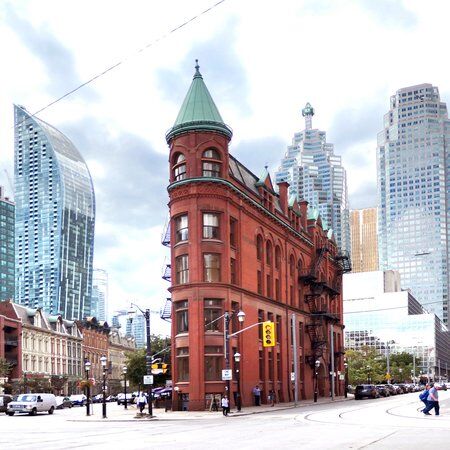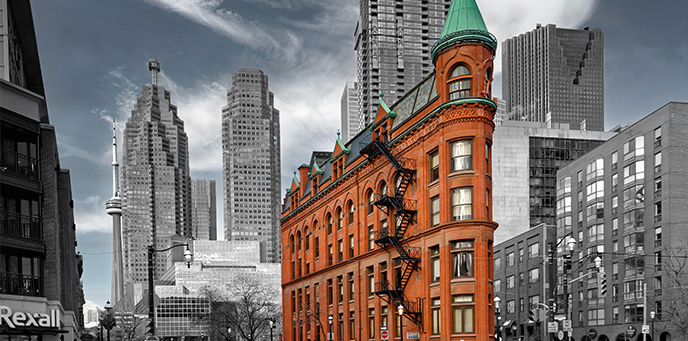Gooderham Building Entrance Fee: Information for Visitors About Costs.: Seasonal Weather and Close-by Spots Can Make It Memorable.}
Gooderham Building Entrance Fee: Information for Visitors About Costs.: Seasonal Weather and Close-by Spots Can Make It Memorable.}
Blog Article
Uncover the Rich History Behind the Gooderham Building in Toronto
The Gooderham Building, an excellent symptom of Richardsonian Romanesque design in Toronto, has a fabled past that prolongs beyond its striking red brick façade. Commissioned by the influential Gooderham and Worts distillery in 1891, this structure has played a crucial duty in shaping the urban landscape of the St. Lawrence Market area.

Origins of the Gooderham Building
Building an enduring heritage, the Gooderham Structure, likewise recognized as the Flatiron Building, became a sign of Toronto's architectural development in the late 19th century. The building's origins trace back to 1891 when it was commissioned by the Gooderham and Worts distillery, among copyright's largest distilling business. Developed by architect David Roberts Jr. Gooderham Building address., the framework was distinctively placed at the junction of Front and Wellington Streets, capitalizing on a triangular great deal developed by the merging of these thoroughfares
The building's building and construction made use of neighborhood red block and terracotta, developing a distinctive aesthetic that matched the growing cityscape. Originally intended to house the Gooderham and Worts offices, the structure represented the success of the distillery, which had become a significant factor to Toronto's economic climate. Notably, the conclusion of the Gooderham Building accompanied a period of rapid urbanization that characterized the age.
The establishment of this architectural gem not only showcased ingenious style but likewise laid the groundwork for future advancements in Toronto. Today, it stands as a testament to the city's abundant history and versatility, proceeding to attract visitors and admirers from around the globe.
Architectural Importance
The architectural significance of the Gooderham Building prolongs beyond its distinct flatiron shape, mirroring the innovative spirit of late 19th-century layout. Completed in 1892, the framework exhibits the Richardsonian Romanesque style, characterized by its robust stonework, rounded arcs, and intricate detailing. The vibrant use contrasting products, specifically the cozy red block and limestone accents, enhances its aesthetic charm and demonstrates the workmanship of the period.
The structure's three-story design is notable for its harmonious percentages and elegant cornice, which add to its renowned shape versus the Toronto horizon. The narrow whole lot on which it stands positioned distinct obstacles, yet the designers, in this case, made a structure that took full advantage of the offered space while keeping aesthetic balance.
Additionally, the Gooderham Structure is a testimony to the versatility of building design in metropolitan environments. Its long-lasting presence amidst modern-day growths highlights the value of maintaining historic style as a way of recognizing a city's past. Today, it remains a precious site, mirroring both the building trends of its time and the progressing narrative of Toronto as a vivid metropolitan center.
Role in Toronto's Growth
Emerging as a principal in Toronto's urban landscape, the Gooderham Structure added significantly to the city's advancement during the late 19th century. Constructed in 1892, this renowned building stood for not only the building ambitions of the moment however additionally the blossoming economic landscape of Toronto. The building was at first created to serve as a warehouse for the Gooderham and Worts distillery, which was one of the largest distilleries in the British Empire. Its calculated area at the junction of Front and Wellington Streets helped with the activity of goods and services, emphasizing the location's significance in the city's commercial tasks.
As the city broadened, the Gooderham Building ended up being a vital component of the St. Lawrence Market area, which was a hub of profession and commerce. Its special building design and popular existence drew interest, affecting the design of subsequent buildings around. Moreover, the structure's survival with various financial changes and city advancements mirrors the resilience and versatility of Toronto's historical landscape. Essentially, the Gooderham Structure is not simply an architectural spots; it played a critical role fit Toronto's identification and economic growth throughout a transformative period in its history.
Social Effect and Heritage
Gooderham Building's distinct architectural design and historic significance have actually left an enduring mark on Toronto's cultural landscape. As one of the city's most identifiable landmarks, its one-of-a-kind flatiron form and elaborate brickwork exhibit the Victorian building patterns of the late 19th century. This framework not only serves as an aesthetic anchor in the St. Lawrence neighborhood but additionally embodies the spirit of an expanding city during a period of financial development.
The structure has ended up being a symbol of Toronto's abundant history, inspiring local artists and digital photographers that seek to capture its appeal. Its visibility has promoted a sense of area identification, adding to the story of metropolitan development. Additionally, the Gooderham Structure has actually played a crucial function in the tourism field, drawing in visitors anxious to explore its storied past and building charm.
Along with its visual charm, the structure encapsulates a story of resilience and adaptation, as it has actually transitioned through different uses over the decades - Gooderham Building address. Therefore, the Gooderham Structure stands not only as a monolith of architectural importance yet additionally link as a testimony to the advancing social heritage of Toronto

Reconstruction and Preservation Efforts
Countless repair and preservation initiatives have actually been carried out to make sure the Gooderham Structure stays an essential part of Toronto's building heritage. Initially completed in 1892, the building has undergone substantial restorations to deal with architectural problems while preserving its historical integrity. The most remarkable remediation took place in the late 20th century when the building was thoroughly reconditioned to satisfy modern safety standards without endangering its initial layout elements.
These efforts consisted of fixing the distinct red-brick façade, bring back the legendary triangular shape, and maintaining the intricate masonry details. In addition, the structure's interior has actually seen cautious updates that value its historic value, making sure that initial functions such as wooden beam of lights and ornamental moldings are maintained.
The Gooderham Structure is now safeguarded as a designated heritage building under the Ontario Heritage Act, which helps safeguard it from inappropriate modifications. Neighborhood involvement has actually played an essential role in these preservation efforts, with neighborhood campaigning for groups increasing recognition regarding the building's historic value. Consequently, the Gooderham Structure stands not just as a practical area but additionally as a testament to Toronto's rich architectural history and sustaining social heritage.
Final Thought

Please visit one of our local supporters - Gamerama And The Repair Store - Iphone Repair North York
Report this page